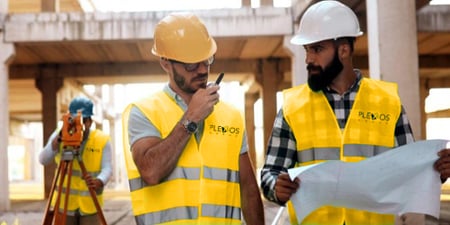3 min read
Stronger Together: For Lasting Disaster Recovery Results, Long-term Interagency Coordination is Key
Plexos Group
14 April 2023

When a natural disaster strikes, state, county, and local response organizations mobilize quickly. They are supported through standardized – and often well-exercised – Incident Command System structures to address critical response and short-term recovery needs. But the need for interagency coordination does not end when incident command is demobilized.
States that are thinking about their recovery holistically require a wide range of stakeholders to map out and address the long-term, unique needs of their communities. Without streamlined management structures and clear communications, multiple agencies can end up confusing and overwhelming local end users. Quite quickly, well-intentioned support results in siloed efforts, conflicting funding advice, and a duplication of efforts that can limit their ability to rebuild and recover in the long term.
In response to the recent New Mexico wildfires – and as the state began to enter medium- to long-term recovery horizons – Plexos facilitated the launch of Lines of Effort which provide targeted focus to the unique needs of New Mexicans in the impacted areas. The Lines of Effort are managed through a program-wide coordination structure, or Unified Command Group, comprising state and federal agency leaders who are working together to achieve clear and measurable goals for the state’s recovery and long-term growth.
HOW DO LINES OF EFFORT WORK?
Lines of Effort serve as an alternative to Recovery Support Functions – a standard organizational structure provided by the National Disaster Recovery Framework. They provide a set of self-defined groups and focus areas that can target the unique needs of a disaster. For example, rather than having a general group to address infrastructure, New Mexico has targeted efforts focused on drinking water and watershed mitigation, which are more critical needs requiring leadership and coordination.
Through the Lines of Effort, and under the leadership of the Unified Command Group, the state is better positioned to address its unmet needs and achieve its mission to speed recovery assistance to every household that needs it by gaining access to a broader selection of federal grant funding opportunities.
Here are a few of the ways a coordinated effort can evolve out of response and into recovery to help a state and all agencies involved focus their efforts on a meaningful and long-term recovery effort:
BUILDING A FRAMEWORK FOR INTERAGENCY COORDINATION
In the aftermath of a disaster, knowing who is already on the ground, and what functions they are performing, is paramount. For the immediate aftermath of a disaster, many state pre-disaster plans outline who has been contracted for this contingency. Working quickly to connect with Voluntary Organizations Active in Disaster (VOADs), long-term recovery groups and centers, and other community resources can build a community-centered coordination structure for addressing critical needs.
As states transition into their longer-term recovery effort, it is important to expand the scope of these partnership networks to engage other key stakeholders in community development: councils of government, watershed alliances, university, and other academic partners, economic development districts, chambers of commerce, and other local organizations that serve as partners to state programs. These organizations can champion community recovery efforts that align with their mission. By expanding the time frame and scope of partnership after the disaster, states accomplish two key objectives:
- Build a coordinated network and base of responsibility for a smooth handoff process so that the maximum number of programs can be championed at the local level.
- Ensure everyone involved is aligning their approach through measurable metrics and milestones so that across multiple programs and efforts, broader goals can be accomplished.
AVOIDING DUPLICATION OF EFFORTS
Local officials are often inundated with offers for assistance at the outset and overwhelmed by meetings. This can lead to a disjointed approach, and worse, duplication of efforts. Detailed time-lined tasks with clear responsibilities and trackable case transfer protocols empower each agency and organization to understand its role in the state’s recovery success. They can also help lay the groundwork for a stronger, more efficient set of solutions throughout the disaster recovery lifecycle.
This level of focus on building efficient solutions also sets the foundation for agencies to remain focused on the most critical needs at the local level. By collaborating with one another – and subsequently, with local partners – the needs expressed by local partners are understood through multiple lenses. Rather than duplicating efforts, agencies are piecing together the elements of their recovery capabilities to fully address challenges.
GENERATING BUY-IN FROM STATE AGENCIES
After the initial response phase, many state agencies feel pressured to get back to their ongoing responsibilities as they struggle to find the capacity to continue to focus on mid-term and long-term recovery efforts. When states cannot sustain disaster response expectations across these agencies, they can build sustainability by:
- Adding long-term responsibilities to existing positions (and delegating previous aspects of those roles to make them sustainable);
- Creating new, designated roles that are assigned to support disaster recovery; or
- By tapping into lead agencies for capacity and using resources to provide guidance and connectivity to partners (rather than direct support).
For whichever of these steps an agency chooses to take, it is imperative to build strong relationships with those agencies to generate sustained support and trust, particularly through training and program evaluation. Through defined Lines of Effort, partners can then work towards a set of attainable milestones and tangible outcomes, collectively realizing their vision of what recovery can look like. Armed with that information, agencies are then positioned to elicit high-value federal funding sources including and beyond FEMA and HUD resources to support their priorities while improving community and economic outcomes.
About Plexos Group
 Plexos Group supports SLTT governments across the country in managing federal funding programs including the American Rescue Plan, Bipartisan Infrastructure Law, FEMA, HUD, and other funding programs as well as implementing large-scale, complex infrastructure projects made possible through public and private funding.
Plexos Group supports SLTT governments across the country in managing federal funding programs including the American Rescue Plan, Bipartisan Infrastructure Law, FEMA, HUD, and other funding programs as well as implementing large-scale, complex infrastructure projects made possible through public and private funding.
Contact Us to learn more about how we can help your organization maximize federal funding programs, limit risk, maintain compliance with federal laws, and leverage Projexis™ technology to expedite your next project.



-1.jpg?width=450&name=1600%20x%20900%20-%20Plexos%20(13)-1.jpg)
